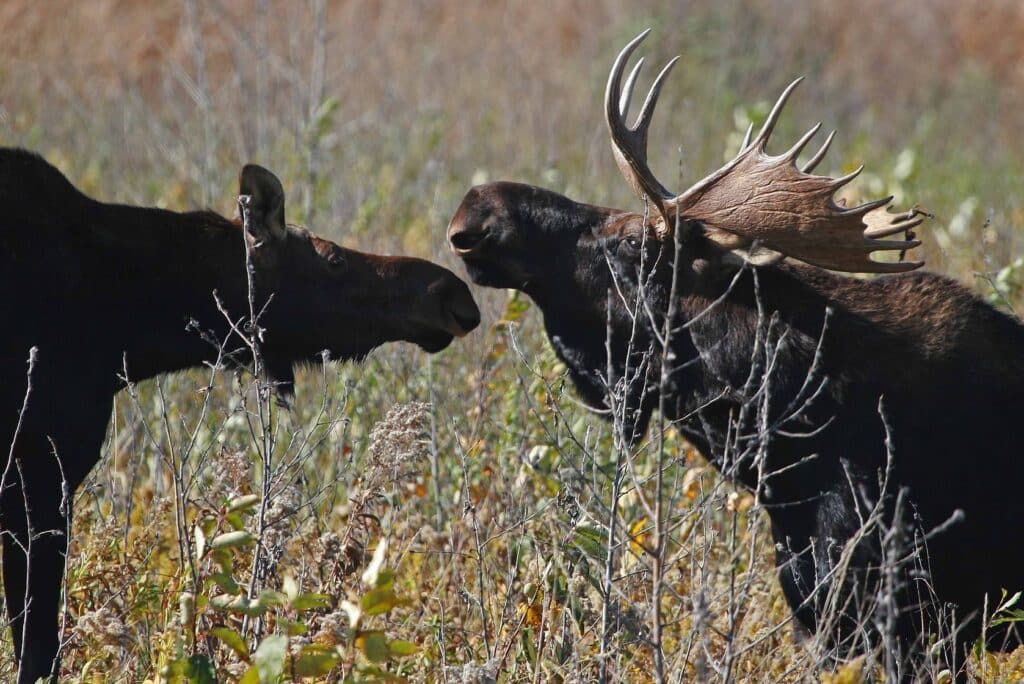
A coalition of public and private groups is embarking on the fourth phase of an ongoing project to enhance forests for the benefit of Minnesota’s imperiled moose population. With funding from the 2008 Minnesota Legacy Amendment, the Minnesota Moose Collaborative has already improved habitat on about 22,500 acres in the past decade. A new $1.8 million grant will help restore another 8,000 acres.
Minnesota’s moose population began dropping drastically in the mid-2000s. Today’s population is less than half what it was 20 years ago. Causes include parasites, wolf predation, increased white-tailed deer numbers, global warming, and loss of habitat.
The Minnesota Moose Collaborative is trying to address the habitat issue.
“Moose have to have two things: good forage and good cover,” says Mike Schrage, wildlife biologist for the Fond Du Lac Band of Lake Superior Chippewa, one of the project partners.
The latest state grant will support more work with a mix of management actions. Workers are clearing brush on thousands of acres to let low shrubs grow better, which provides valuable food for moose. They are also replanting thousands of acres with trees that offer the kind of cover moose need in both winter and summer. The mix of white pine and white spruce, along with some white cedar and red oak, will offer shade in the summer and shelter in the winter.
The project won’t just benefit moose, either, as the work will enhance habitat for many types of wildlife.
“Ultimately, this project will encourage a heterogeneous forest habitat matrix resulting in a landscape that is more
resilient, providing for an ecologically diverse and balanced landscape condition with greater benefit to moose,
[Species of Greatest Conservation Need] species, and wildlife as a whole,” the grant application says.
Project partners include numerous groups and agencies. The Ruffed Grouse Society is taking over from the Minnesota Deer Hunters Association as the lead group on the grant. The Nature Conservancy is organizing much of the labor, with its crews in charge of the actual restoration. Governments involved include St. Louis, Lake, and Cook Counties, the U.S. Forest Service, Minnesota Department of Natural Resources, and the Fond du Lac Band of Lake Superior Chippewa. The University of Minnesota’s Natural Resources Research Institute in Duluth is also providing scientific expertise.
The project has received millions in previous funding for its work, thanks to the Legacy Amendment’s Outdoor Heritage Fund. The Lessard-Sams Outdoor Heritage Council reviews proposals for the funds and makes recommendations. The council supports the project because if its broad impacts.
“I think the council really looked at the scope of the project, not just the plight of the moose and the reducing numbers of moose that were happening, but looked at the overall ecology and the overall health of the forest in this area of the state,” said Lessard-Sams Outdoor Council Executive Director Mark Johnson, according to WDIO. “By helping the moose, they felt that, okay, it’s not just helping the moose, but improving this habitat is also improving the habitat for our other game and non-game species. The Neotropical migratory songbirds, the grouse, the deer, everything else. So it’s a really encompassing habitat enhancement project because it’s doing great work.”
The application says the coalition’s goal is to maintain the moose population at least at its current size.
More information:
- Minnesota Moose Habitat Collaborative enters fourth phase of forest enhancement – WDIO
- Moose Habitat Collaborative Phase IV – Ruffed Grouse Society
- Partnership Works to Help Moose – The Nature Conservancy

